Report on Developing Relationships and Workplace Achievement at Tesco
VerifiedAdded on 2023/01/05
|16
|4590
|2
Report
AI Summary
This report delves into the strategies Tesco employs to cultivate strong workplace relationships and achieve organizational goals. It examines key aspects of human resource management, including recruitment, selection, and employee development. The report explores the significance of employee motivation, differentiating between intrinsic and extrinsic motivators, and analyzes various motivational theories like Maslow's hierarchy and Vroom's expectancy theory. Organizational commitment is also discussed, highlighting its importance for employee retention and business success, while also addressing potential challenges and factors affecting commitment. Furthermore, the report evaluates the roles and responsibilities of line managers in supporting HR functions and assesses the impact of training, development, and reward systems on employee satisfaction and organizational performance, particularly in the context of economic downturns like the COVID-19 pandemic. The report also includes a PDP plan and concludes with a summary of the key findings and recommendations.
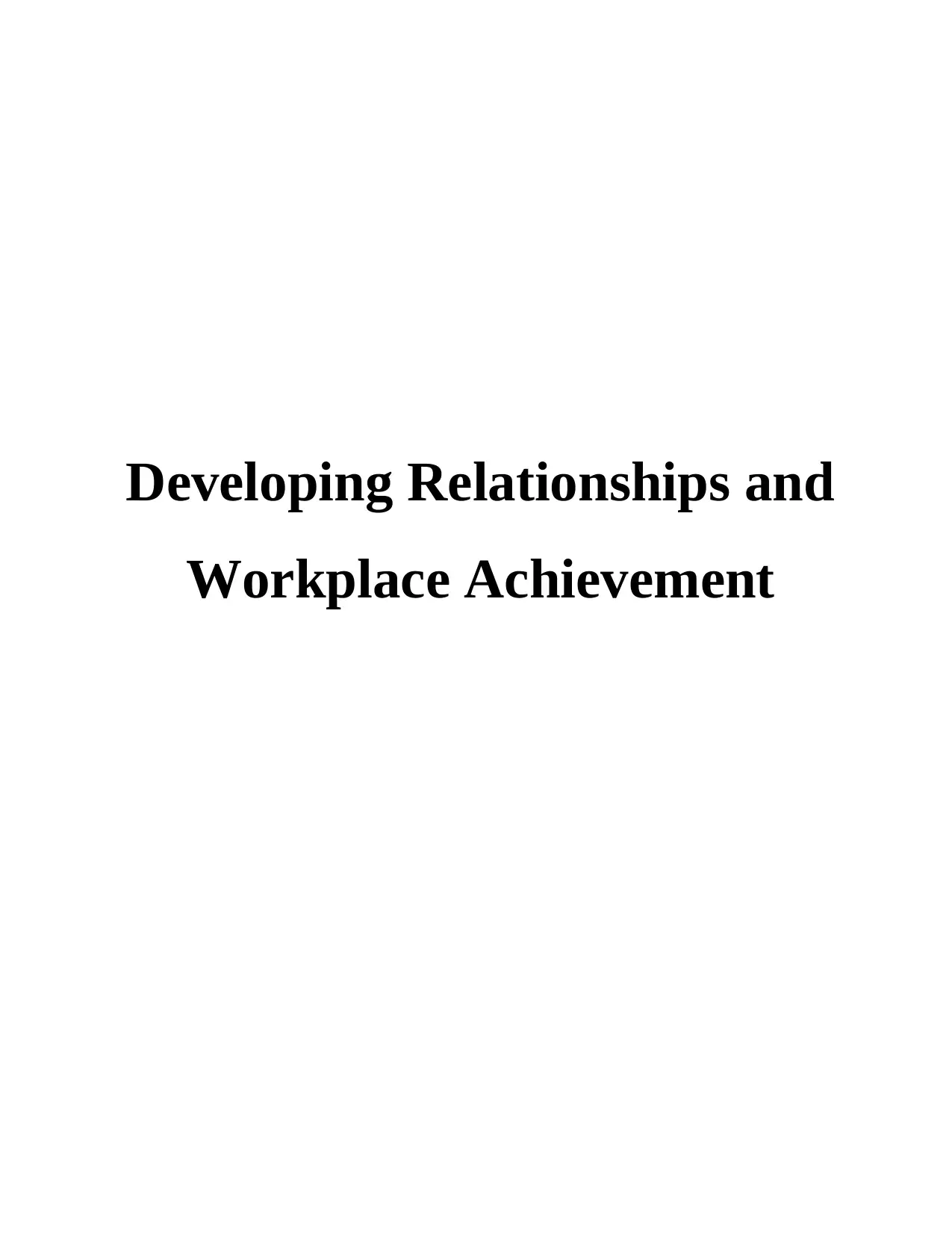
Developing Relationships and
Workplace Achievement
Workplace Achievement
Paraphrase This Document
Need a fresh take? Get an instant paraphrase of this document with our AI Paraphraser
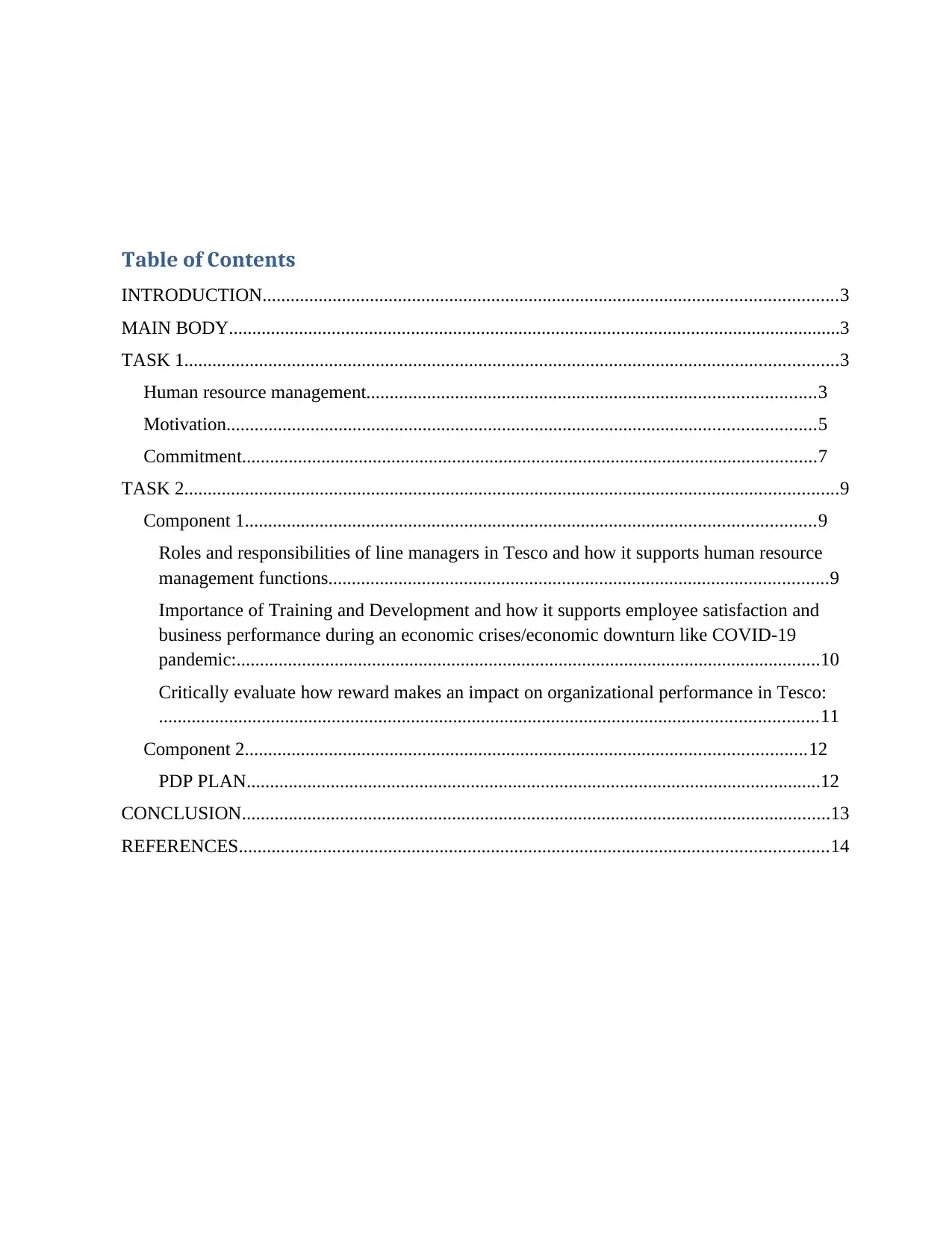
Table of Contents
INTRODUCTION...........................................................................................................................3
MAIN BODY...................................................................................................................................3
TASK 1............................................................................................................................................3
Human resource management................................................................................................3
Motivation..............................................................................................................................5
Commitment...........................................................................................................................7
TASK 2............................................................................................................................................9
Component 1..........................................................................................................................9
Roles and responsibilities of line managers in Tesco and how it supports human resource
management functions...........................................................................................................9
Importance of Training and Development and how it supports employee satisfaction and
business performance during an economic crises/economic downturn like COVID-19
pandemic:.............................................................................................................................10
Critically evaluate how reward makes an impact on organizational performance in Tesco:
.............................................................................................................................................11
Component 2........................................................................................................................12
PDP PLAN...........................................................................................................................12
CONCLUSION..............................................................................................................................13
REFERENCES..............................................................................................................................14
INTRODUCTION...........................................................................................................................3
MAIN BODY...................................................................................................................................3
TASK 1............................................................................................................................................3
Human resource management................................................................................................3
Motivation..............................................................................................................................5
Commitment...........................................................................................................................7
TASK 2............................................................................................................................................9
Component 1..........................................................................................................................9
Roles and responsibilities of line managers in Tesco and how it supports human resource
management functions...........................................................................................................9
Importance of Training and Development and how it supports employee satisfaction and
business performance during an economic crises/economic downturn like COVID-19
pandemic:.............................................................................................................................10
Critically evaluate how reward makes an impact on organizational performance in Tesco:
.............................................................................................................................................11
Component 2........................................................................................................................12
PDP PLAN...........................................................................................................................12
CONCLUSION..............................................................................................................................13
REFERENCES..............................................................................................................................14
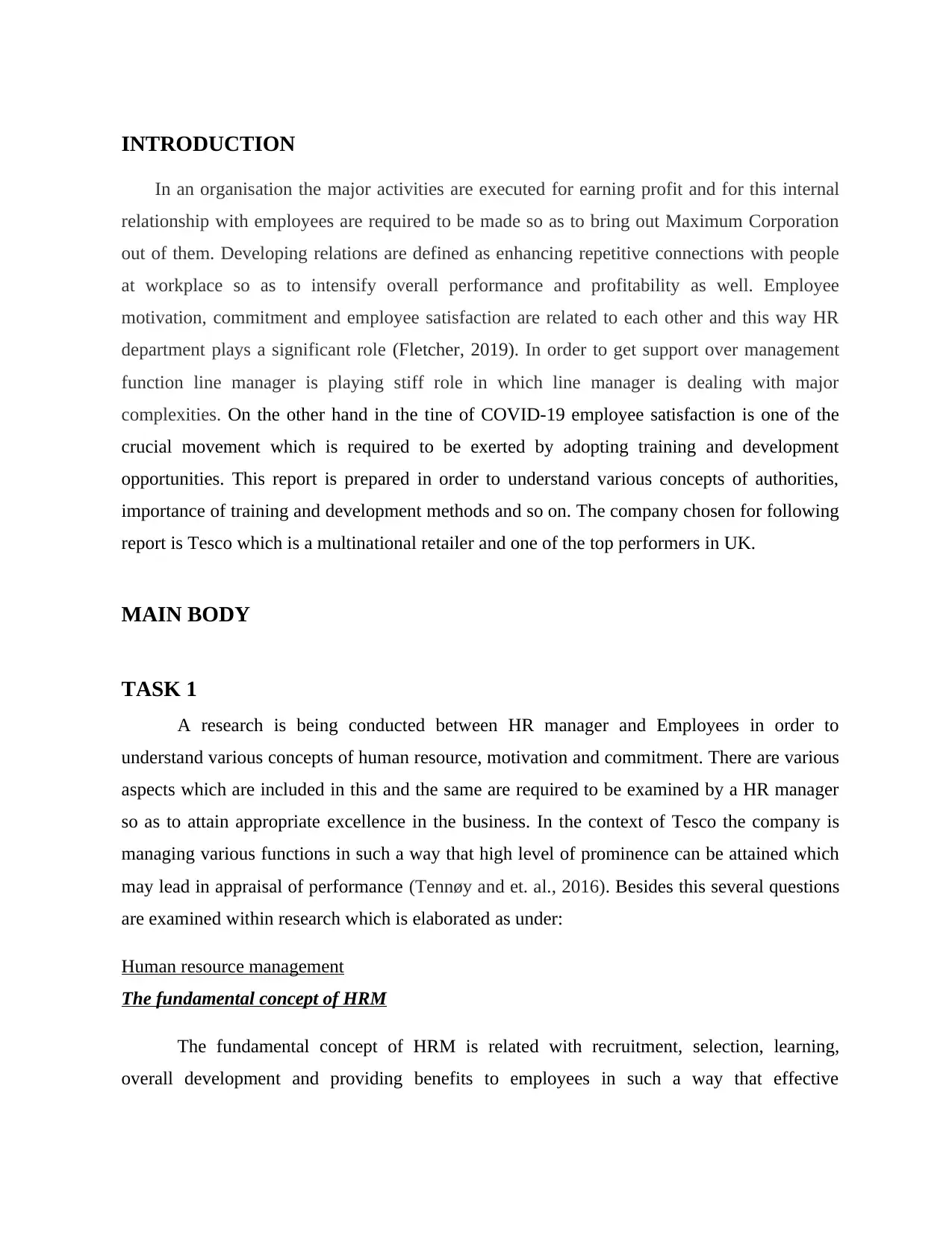
INTRODUCTION
In an organisation the major activities are executed for earning profit and for this internal
relationship with employees are required to be made so as to bring out Maximum Corporation
out of them. Developing relations are defined as enhancing repetitive connections with people
at workplace so as to intensify overall performance and profitability as well. Employee
motivation, commitment and employee satisfaction are related to each other and this way HR
department plays a significant role (Fletcher, 2019). In order to get support over management
function line manager is playing stiff role in which line manager is dealing with major
complexities. On the other hand in the tine of COVID-19 employee satisfaction is one of the
crucial movement which is required to be exerted by adopting training and development
opportunities. This report is prepared in order to understand various concepts of authorities,
importance of training and development methods and so on. The company chosen for following
report is Tesco which is a multinational retailer and one of the top performers in UK.
MAIN BODY
TASK 1
A research is being conducted between HR manager and Employees in order to
understand various concepts of human resource, motivation and commitment. There are various
aspects which are included in this and the same are required to be examined by a HR manager
so as to attain appropriate excellence in the business. In the context of Tesco the company is
managing various functions in such a way that high level of prominence can be attained which
may lead in appraisal of performance (Tennøy and et. al., 2016). Besides this several questions
are examined within research which is elaborated as under:
Human resource management
The fundamental concept of HRM
The fundamental concept of HRM is related with recruitment, selection, learning,
overall development and providing benefits to employees in such a way that effective
In an organisation the major activities are executed for earning profit and for this internal
relationship with employees are required to be made so as to bring out Maximum Corporation
out of them. Developing relations are defined as enhancing repetitive connections with people
at workplace so as to intensify overall performance and profitability as well. Employee
motivation, commitment and employee satisfaction are related to each other and this way HR
department plays a significant role (Fletcher, 2019). In order to get support over management
function line manager is playing stiff role in which line manager is dealing with major
complexities. On the other hand in the tine of COVID-19 employee satisfaction is one of the
crucial movement which is required to be exerted by adopting training and development
opportunities. This report is prepared in order to understand various concepts of authorities,
importance of training and development methods and so on. The company chosen for following
report is Tesco which is a multinational retailer and one of the top performers in UK.
MAIN BODY
TASK 1
A research is being conducted between HR manager and Employees in order to
understand various concepts of human resource, motivation and commitment. There are various
aspects which are included in this and the same are required to be examined by a HR manager
so as to attain appropriate excellence in the business. In the context of Tesco the company is
managing various functions in such a way that high level of prominence can be attained which
may lead in appraisal of performance (Tennøy and et. al., 2016). Besides this several questions
are examined within research which is elaborated as under:
Human resource management
The fundamental concept of HRM
The fundamental concept of HRM is related with recruitment, selection, learning,
overall development and providing benefits to employees in such a way that effective
You're viewing a preview
Unlock full access by subscribing today!
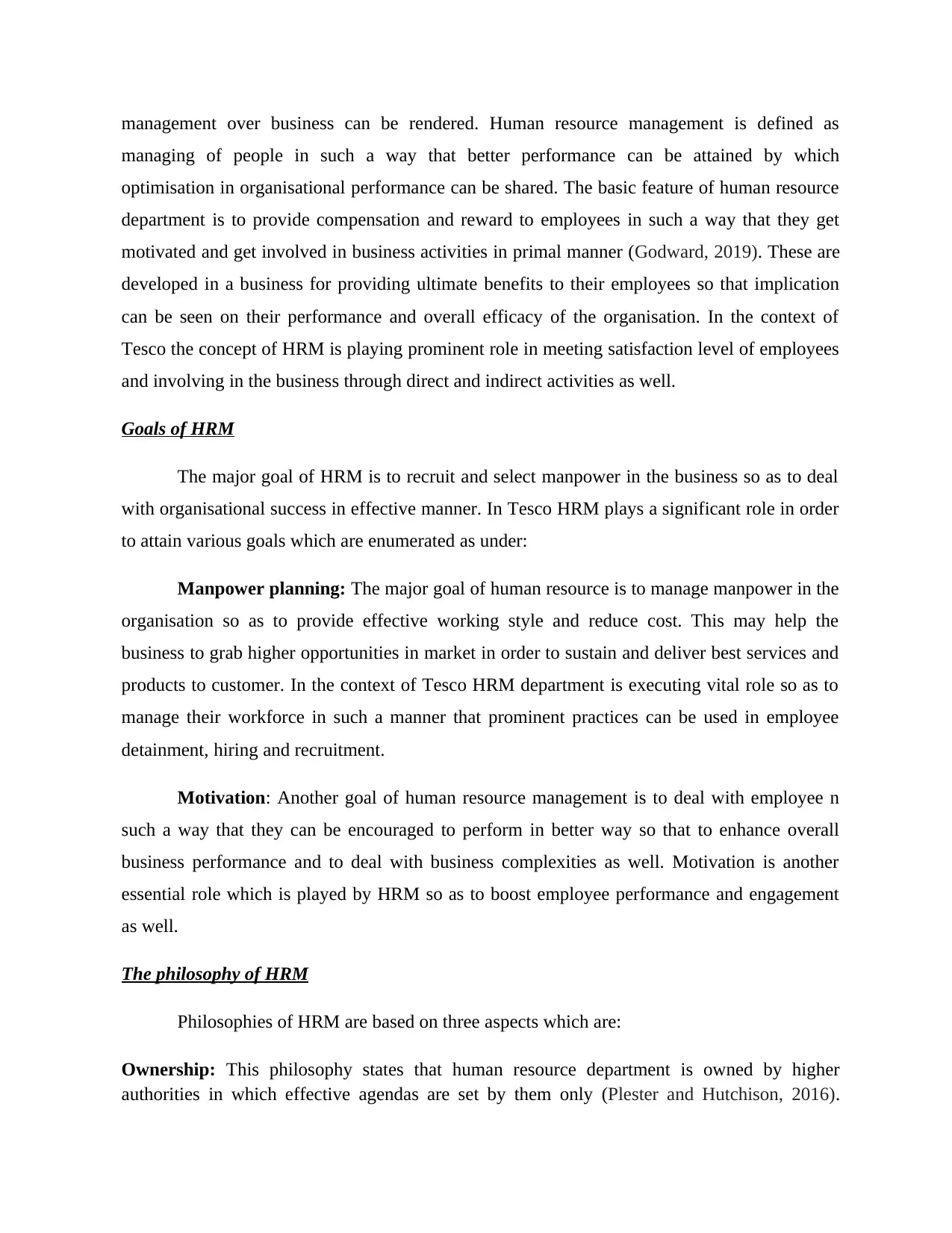
management over business can be rendered. Human resource management is defined as
managing of people in such a way that better performance can be attained by which
optimisation in organisational performance can be shared. The basic feature of human resource
department is to provide compensation and reward to employees in such a way that they get
motivated and get involved in business activities in primal manner (Godward, 2019). These are
developed in a business for providing ultimate benefits to their employees so that implication
can be seen on their performance and overall efficacy of the organisation. In the context of
Tesco the concept of HRM is playing prominent role in meeting satisfaction level of employees
and involving in the business through direct and indirect activities as well.
Goals of HRM
The major goal of HRM is to recruit and select manpower in the business so as to deal
with organisational success in effective manner. In Tesco HRM plays a significant role in order
to attain various goals which are enumerated as under:
Manpower planning: The major goal of human resource is to manage manpower in the
organisation so as to provide effective working style and reduce cost. This may help the
business to grab higher opportunities in market in order to sustain and deliver best services and
products to customer. In the context of Tesco HRM department is executing vital role so as to
manage their workforce in such a manner that prominent practices can be used in employee
detainment, hiring and recruitment.
Motivation: Another goal of human resource management is to deal with employee n
such a way that they can be encouraged to perform in better way so that to enhance overall
business performance and to deal with business complexities as well. Motivation is another
essential role which is played by HRM so as to boost employee performance and engagement
as well.
The philosophy of HRM
Philosophies of HRM are based on three aspects which are:
Ownership: This philosophy states that human resource department is owned by higher
authorities in which effective agendas are set by them only (Plester and Hutchison, 2016).
managing of people in such a way that better performance can be attained by which
optimisation in organisational performance can be shared. The basic feature of human resource
department is to provide compensation and reward to employees in such a way that they get
motivated and get involved in business activities in primal manner (Godward, 2019). These are
developed in a business for providing ultimate benefits to their employees so that implication
can be seen on their performance and overall efficacy of the organisation. In the context of
Tesco the concept of HRM is playing prominent role in meeting satisfaction level of employees
and involving in the business through direct and indirect activities as well.
Goals of HRM
The major goal of HRM is to recruit and select manpower in the business so as to deal
with organisational success in effective manner. In Tesco HRM plays a significant role in order
to attain various goals which are enumerated as under:
Manpower planning: The major goal of human resource is to manage manpower in the
organisation so as to provide effective working style and reduce cost. This may help the
business to grab higher opportunities in market in order to sustain and deliver best services and
products to customer. In the context of Tesco HRM department is executing vital role so as to
manage their workforce in such a manner that prominent practices can be used in employee
detainment, hiring and recruitment.
Motivation: Another goal of human resource management is to deal with employee n
such a way that they can be encouraged to perform in better way so that to enhance overall
business performance and to deal with business complexities as well. Motivation is another
essential role which is played by HRM so as to boost employee performance and engagement
as well.
The philosophy of HRM
Philosophies of HRM are based on three aspects which are:
Ownership: This philosophy states that human resource department is owned by higher
authorities in which effective agendas are set by them only (Plester and Hutchison, 2016).
Paraphrase This Document
Need a fresh take? Get an instant paraphrase of this document with our AI Paraphraser
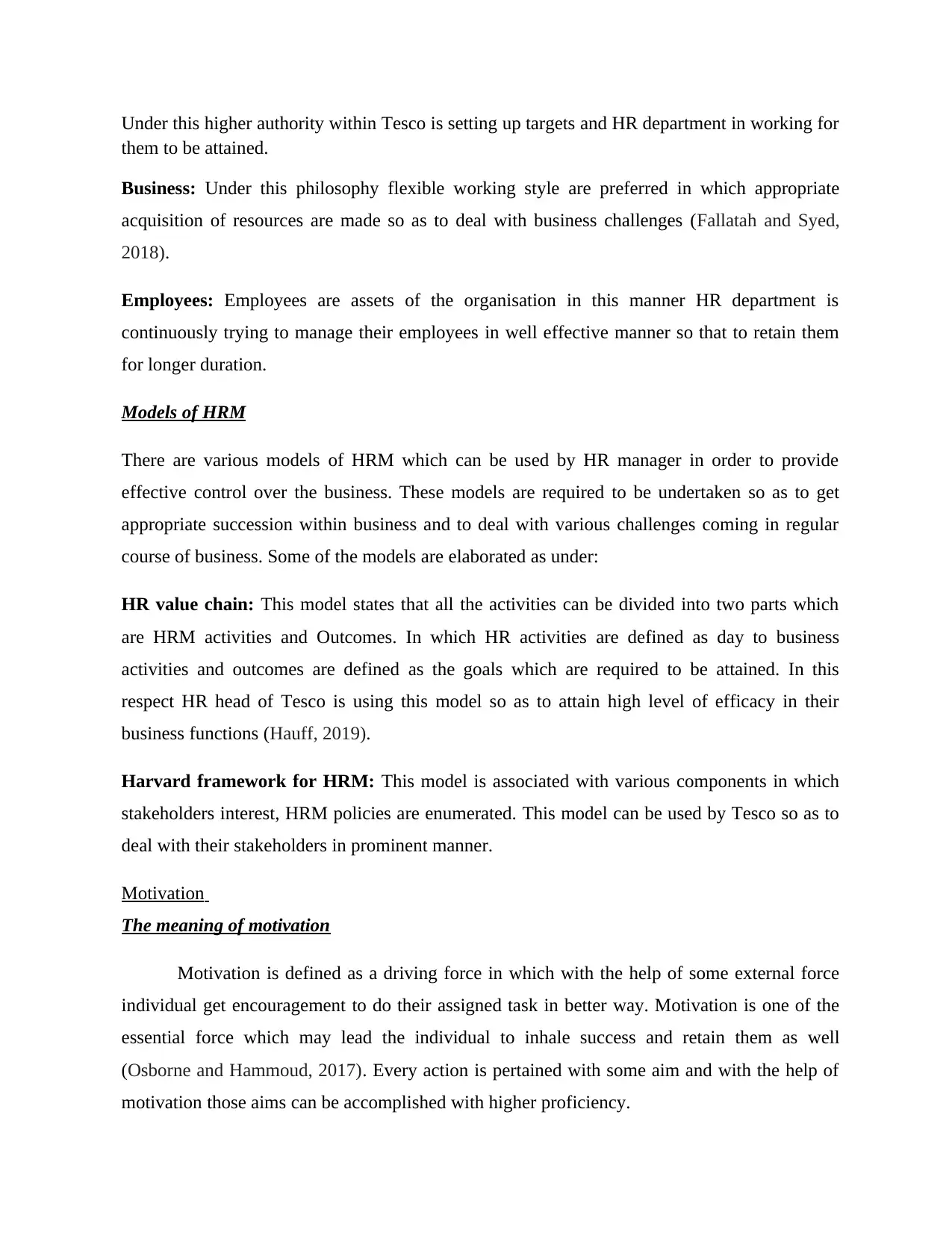
Under this higher authority within Tesco is setting up targets and HR department in working for
them to be attained.
Business: Under this philosophy flexible working style are preferred in which appropriate
acquisition of resources are made so as to deal with business challenges (Fallatah and Syed,
2018).
Employees: Employees are assets of the organisation in this manner HR department is
continuously trying to manage their employees in well effective manner so that to retain them
for longer duration.
Models of HRM
There are various models of HRM which can be used by HR manager in order to provide
effective control over the business. These models are required to be undertaken so as to get
appropriate succession within business and to deal with various challenges coming in regular
course of business. Some of the models are elaborated as under:
HR value chain: This model states that all the activities can be divided into two parts which
are HRM activities and Outcomes. In which HR activities are defined as day to business
activities and outcomes are defined as the goals which are required to be attained. In this
respect HR head of Tesco is using this model so as to attain high level of efficacy in their
business functions (Hauff, 2019).
Harvard framework for HRM: This model is associated with various components in which
stakeholders interest, HRM policies are enumerated. This model can be used by Tesco so as to
deal with their stakeholders in prominent manner.
Motivation
The meaning of motivation
Motivation is defined as a driving force in which with the help of some external force
individual get encouragement to do their assigned task in better way. Motivation is one of the
essential force which may lead the individual to inhale success and retain them as well
(Osborne and Hammoud, 2017). Every action is pertained with some aim and with the help of
motivation those aims can be accomplished with higher proficiency.
them to be attained.
Business: Under this philosophy flexible working style are preferred in which appropriate
acquisition of resources are made so as to deal with business challenges (Fallatah and Syed,
2018).
Employees: Employees are assets of the organisation in this manner HR department is
continuously trying to manage their employees in well effective manner so that to retain them
for longer duration.
Models of HRM
There are various models of HRM which can be used by HR manager in order to provide
effective control over the business. These models are required to be undertaken so as to get
appropriate succession within business and to deal with various challenges coming in regular
course of business. Some of the models are elaborated as under:
HR value chain: This model states that all the activities can be divided into two parts which
are HRM activities and Outcomes. In which HR activities are defined as day to business
activities and outcomes are defined as the goals which are required to be attained. In this
respect HR head of Tesco is using this model so as to attain high level of efficacy in their
business functions (Hauff, 2019).
Harvard framework for HRM: This model is associated with various components in which
stakeholders interest, HRM policies are enumerated. This model can be used by Tesco so as to
deal with their stakeholders in prominent manner.
Motivation
The meaning of motivation
Motivation is defined as a driving force in which with the help of some external force
individual get encouragement to do their assigned task in better way. Motivation is one of the
essential force which may lead the individual to inhale success and retain them as well
(Osborne and Hammoud, 2017). Every action is pertained with some aim and with the help of
motivation those aims can be accomplished with higher proficiency.
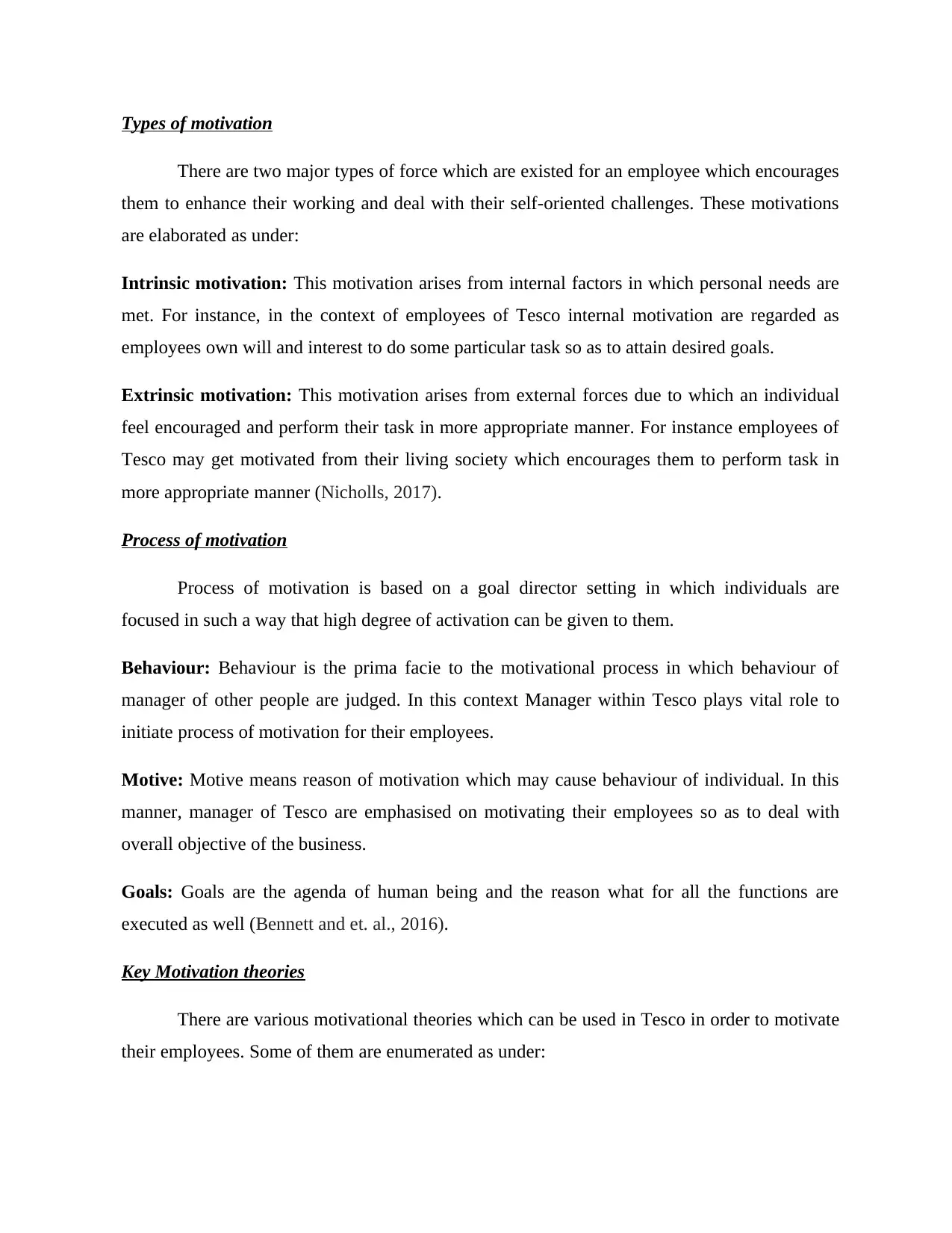
Types of motivation
There are two major types of force which are existed for an employee which encourages
them to enhance their working and deal with their self-oriented challenges. These motivations
are elaborated as under:
Intrinsic motivation: This motivation arises from internal factors in which personal needs are
met. For instance, in the context of employees of Tesco internal motivation are regarded as
employees own will and interest to do some particular task so as to attain desired goals.
Extrinsic motivation: This motivation arises from external forces due to which an individual
feel encouraged and perform their task in more appropriate manner. For instance employees of
Tesco may get motivated from their living society which encourages them to perform task in
more appropriate manner (Nicholls, 2017).
Process of motivation
Process of motivation is based on a goal director setting in which individuals are
focused in such a way that high degree of activation can be given to them.
Behaviour: Behaviour is the prima facie to the motivational process in which behaviour of
manager of other people are judged. In this context Manager within Tesco plays vital role to
initiate process of motivation for their employees.
Motive: Motive means reason of motivation which may cause behaviour of individual. In this
manner, manager of Tesco are emphasised on motivating their employees so as to deal with
overall objective of the business.
Goals: Goals are the agenda of human being and the reason what for all the functions are
executed as well (Bennett and et. al., 2016).
Key Motivation theories
There are various motivational theories which can be used in Tesco in order to motivate
their employees. Some of them are enumerated as under:
There are two major types of force which are existed for an employee which encourages
them to enhance their working and deal with their self-oriented challenges. These motivations
are elaborated as under:
Intrinsic motivation: This motivation arises from internal factors in which personal needs are
met. For instance, in the context of employees of Tesco internal motivation are regarded as
employees own will and interest to do some particular task so as to attain desired goals.
Extrinsic motivation: This motivation arises from external forces due to which an individual
feel encouraged and perform their task in more appropriate manner. For instance employees of
Tesco may get motivated from their living society which encourages them to perform task in
more appropriate manner (Nicholls, 2017).
Process of motivation
Process of motivation is based on a goal director setting in which individuals are
focused in such a way that high degree of activation can be given to them.
Behaviour: Behaviour is the prima facie to the motivational process in which behaviour of
manager of other people are judged. In this context Manager within Tesco plays vital role to
initiate process of motivation for their employees.
Motive: Motive means reason of motivation which may cause behaviour of individual. In this
manner, manager of Tesco are emphasised on motivating their employees so as to deal with
overall objective of the business.
Goals: Goals are the agenda of human being and the reason what for all the functions are
executed as well (Bennett and et. al., 2016).
Key Motivation theories
There are various motivational theories which can be used in Tesco in order to motivate
their employees. Some of them are enumerated as under:
You're viewing a preview
Unlock full access by subscribing today!

Maslow need hierarchy: Under this theory human needs are focused under which
needs are demonstrated in hierarchical manner in lower to higher order. Under this manage of
Tesco are required to focus on each and every need of employees so as to motivate them and
meet their level of expectation.
Physiological Needs: These needs are related with food, clothing and other needs which are
required for human life.
Safety Needs: These needs are related with desire of safety and protection.
Social Needs: This involves belongingness, companionship.
Esteem Needs: This is related with self-respect, independent, knowledge and capabilities.
Self-Actualisation Needs: This is related with stage of fulfilment (Hezlett, 2016).
Vroom expectancy theory: This is a cognitive process of motivation in which
relationship between performance, efforts and reward is established. This theory states that
level of motivation is equivalent to sum of performance, efforts and reward for an individual.
Commitment
Meaning and characteristics of organizational commitment: Commitment can be
defined as dedication towards a cause or an activity. In terms of Tesco commitment defines its
dedication and efforts towards achieving the organizational goals and visions. It is mindset and
dedication of employee towards the organization he is working for and decides how long he
will be staying attached to the organization and contribute its part towards its goals. The major
characteristics for this are hunger of new challenges; focus on common goal, willingness to lead
from front and best output by the employees towards the organizational goal in most effective
manner. It is necessary for Tesco as well to keep its employees focused and committed towards
organization goals and objectives to achieve the best results (Bourne, 2016).
Importance of Commitment: There are several importance to stay committed in the
organization for both employees as well as organization. The most important is that it helps
them to meets their goals and objectives in the planned manner and stick to its optimistic
visions. Employee retention is one of the other positive result of commitment as it will create a
work friendly environment which would make employees feel safe and secure and enhance his
needs are demonstrated in hierarchical manner in lower to higher order. Under this manage of
Tesco are required to focus on each and every need of employees so as to motivate them and
meet their level of expectation.
Physiological Needs: These needs are related with food, clothing and other needs which are
required for human life.
Safety Needs: These needs are related with desire of safety and protection.
Social Needs: This involves belongingness, companionship.
Esteem Needs: This is related with self-respect, independent, knowledge and capabilities.
Self-Actualisation Needs: This is related with stage of fulfilment (Hezlett, 2016).
Vroom expectancy theory: This is a cognitive process of motivation in which
relationship between performance, efforts and reward is established. This theory states that
level of motivation is equivalent to sum of performance, efforts and reward for an individual.
Commitment
Meaning and characteristics of organizational commitment: Commitment can be
defined as dedication towards a cause or an activity. In terms of Tesco commitment defines its
dedication and efforts towards achieving the organizational goals and visions. It is mindset and
dedication of employee towards the organization he is working for and decides how long he
will be staying attached to the organization and contribute its part towards its goals. The major
characteristics for this are hunger of new challenges; focus on common goal, willingness to lead
from front and best output by the employees towards the organizational goal in most effective
manner. It is necessary for Tesco as well to keep its employees focused and committed towards
organization goals and objectives to achieve the best results (Bourne, 2016).
Importance of Commitment: There are several importance to stay committed in the
organization for both employees as well as organization. The most important is that it helps
them to meets their goals and objectives in the planned manner and stick to its optimistic
visions. Employee retention is one of the other positive result of commitment as it will create a
work friendly environment which would make employees feel safe and secure and enhance his
Paraphrase This Document
Need a fresh take? Get an instant paraphrase of this document with our AI Paraphraser
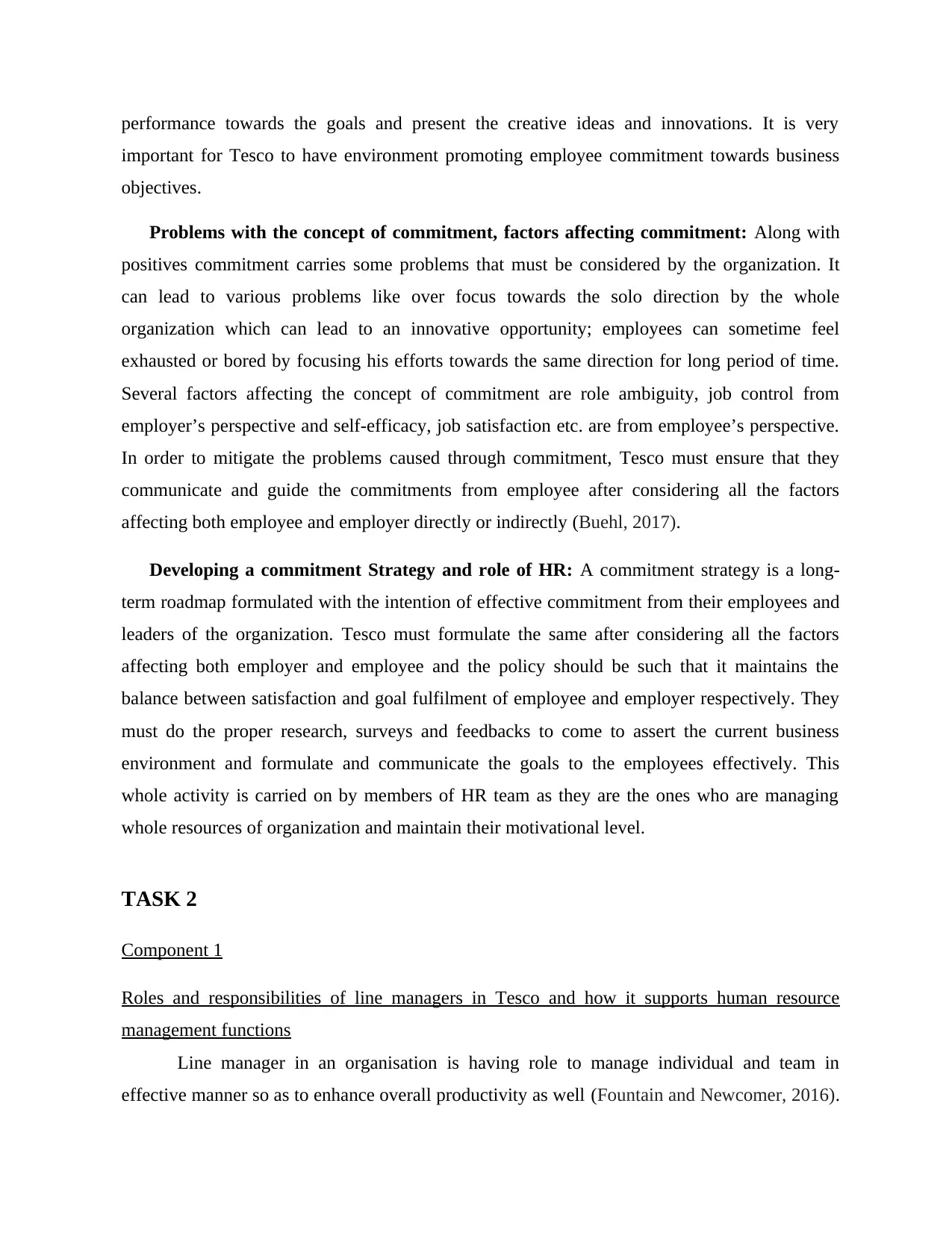
performance towards the goals and present the creative ideas and innovations. It is very
important for Tesco to have environment promoting employee commitment towards business
objectives.
Problems with the concept of commitment, factors affecting commitment: Along with
positives commitment carries some problems that must be considered by the organization. It
can lead to various problems like over focus towards the solo direction by the whole
organization which can lead to an innovative opportunity; employees can sometime feel
exhausted or bored by focusing his efforts towards the same direction for long period of time.
Several factors affecting the concept of commitment are role ambiguity, job control from
employer’s perspective and self-efficacy, job satisfaction etc. are from employee’s perspective.
In order to mitigate the problems caused through commitment, Tesco must ensure that they
communicate and guide the commitments from employee after considering all the factors
affecting both employee and employer directly or indirectly (Buehl, 2017).
Developing a commitment Strategy and role of HR: A commitment strategy is a long-
term roadmap formulated with the intention of effective commitment from their employees and
leaders of the organization. Tesco must formulate the same after considering all the factors
affecting both employer and employee and the policy should be such that it maintains the
balance between satisfaction and goal fulfilment of employee and employer respectively. They
must do the proper research, surveys and feedbacks to come to assert the current business
environment and formulate and communicate the goals to the employees effectively. This
whole activity is carried on by members of HR team as they are the ones who are managing
whole resources of organization and maintain their motivational level.
TASK 2
Component 1
Roles and responsibilities of line managers in Tesco and how it supports human resource
management functions
Line manager in an organisation is having role to manage individual and team in
effective manner so as to enhance overall productivity as well (Fountain and Newcomer, 2016).
important for Tesco to have environment promoting employee commitment towards business
objectives.
Problems with the concept of commitment, factors affecting commitment: Along with
positives commitment carries some problems that must be considered by the organization. It
can lead to various problems like over focus towards the solo direction by the whole
organization which can lead to an innovative opportunity; employees can sometime feel
exhausted or bored by focusing his efforts towards the same direction for long period of time.
Several factors affecting the concept of commitment are role ambiguity, job control from
employer’s perspective and self-efficacy, job satisfaction etc. are from employee’s perspective.
In order to mitigate the problems caused through commitment, Tesco must ensure that they
communicate and guide the commitments from employee after considering all the factors
affecting both employee and employer directly or indirectly (Buehl, 2017).
Developing a commitment Strategy and role of HR: A commitment strategy is a long-
term roadmap formulated with the intention of effective commitment from their employees and
leaders of the organization. Tesco must formulate the same after considering all the factors
affecting both employer and employee and the policy should be such that it maintains the
balance between satisfaction and goal fulfilment of employee and employer respectively. They
must do the proper research, surveys and feedbacks to come to assert the current business
environment and formulate and communicate the goals to the employees effectively. This
whole activity is carried on by members of HR team as they are the ones who are managing
whole resources of organization and maintain their motivational level.
TASK 2
Component 1
Roles and responsibilities of line managers in Tesco and how it supports human resource
management functions
Line manager in an organisation is having role to manage individual and team in
effective manner so as to enhance overall productivity as well (Fountain and Newcomer, 2016).

Line manager in Tesco is having role to recruit and hire talented people in order to fill team
positions and to collect feedbacks from all team members so that to find opportunities for
further improvements. In Tesco, roles and responsibilities of line manager are elaborated as
under:
Examining work and checking quality: Line manager provides instructions to their
employees regarding every work detail so that guide them (Victor and Hoole, 2017). On the
other hand line manager continuously provide quality check within workplace so as to maintain
overall quality in prominent manner. In this respect, line manger within Tesco is executing roles
in which functions of human resources are supported. In this manner line manager are
examining performance of their employees in which high assistance is provided to HR
department.
Promoting equality and diversity: Line manager within an organisation is highly
emphasised over promoting equality and diversity in order to provide diversified working
environment. In this context line manager of Tesco is using various practices by which diversity
within workplace can be promoted. This could lead to supervise function of HR manager in a
manner that they can manage diversified staff at once.
Employee engagement: Employee engagement is one of the prominent aspects which
could help the overall organisation to deal with high end success. With this fuller contribution
of employees can be enumerated which may lead in higher productivity and efficacy as well. In
the context of Tesco the company is highly emphasised in drawing higher employee satisfaction
so as to manage overall working in most effective manner. Under this the major task of HR
manager is to organise such activities by which employee engagement can be enhanced and this
may minimise working of HR as line manager is organising the same.
Utilising practices of health and safety: Another responsibility of line staff is to
manage health and safety measures so as to provide ultimate safety to their employees. In this
role line manager keeps various practices which are aligned with HR functions. This function
helps HR manager to deal with employees in prominent manner (Podgorodnichenko, Edgar and
McAndrew, 2020).
positions and to collect feedbacks from all team members so that to find opportunities for
further improvements. In Tesco, roles and responsibilities of line manager are elaborated as
under:
Examining work and checking quality: Line manager provides instructions to their
employees regarding every work detail so that guide them (Victor and Hoole, 2017). On the
other hand line manager continuously provide quality check within workplace so as to maintain
overall quality in prominent manner. In this respect, line manger within Tesco is executing roles
in which functions of human resources are supported. In this manner line manager are
examining performance of their employees in which high assistance is provided to HR
department.
Promoting equality and diversity: Line manager within an organisation is highly
emphasised over promoting equality and diversity in order to provide diversified working
environment. In this context line manager of Tesco is using various practices by which diversity
within workplace can be promoted. This could lead to supervise function of HR manager in a
manner that they can manage diversified staff at once.
Employee engagement: Employee engagement is one of the prominent aspects which
could help the overall organisation to deal with high end success. With this fuller contribution
of employees can be enumerated which may lead in higher productivity and efficacy as well. In
the context of Tesco the company is highly emphasised in drawing higher employee satisfaction
so as to manage overall working in most effective manner. Under this the major task of HR
manager is to organise such activities by which employee engagement can be enhanced and this
may minimise working of HR as line manager is organising the same.
Utilising practices of health and safety: Another responsibility of line staff is to
manage health and safety measures so as to provide ultimate safety to their employees. In this
role line manager keeps various practices which are aligned with HR functions. This function
helps HR manager to deal with employees in prominent manner (Podgorodnichenko, Edgar and
McAndrew, 2020).
You're viewing a preview
Unlock full access by subscribing today!
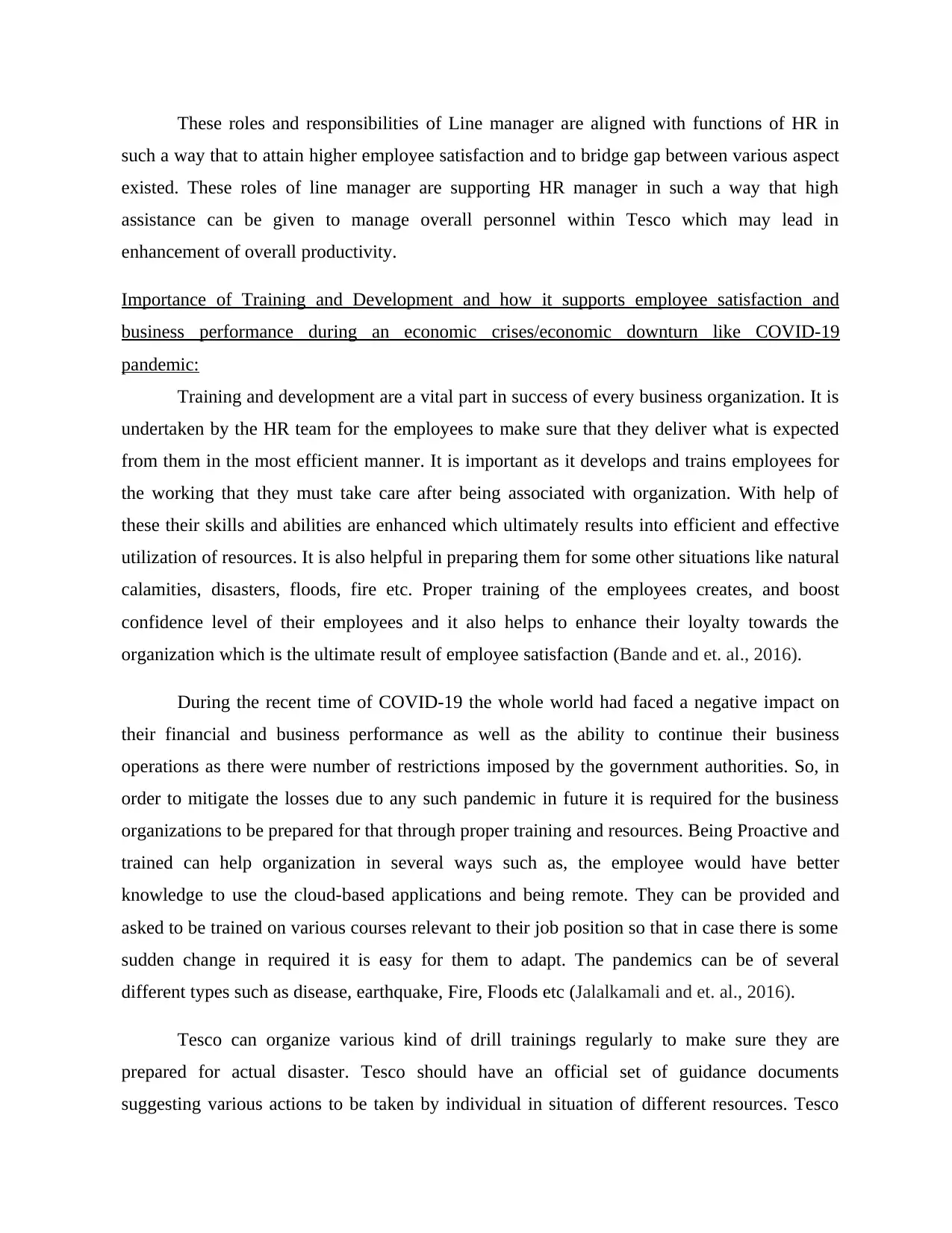
These roles and responsibilities of Line manager are aligned with functions of HR in
such a way that to attain higher employee satisfaction and to bridge gap between various aspect
existed. These roles of line manager are supporting HR manager in such a way that high
assistance can be given to manage overall personnel within Tesco which may lead in
enhancement of overall productivity.
Importance of Training and Development and how it supports employee satisfaction and
business performance during an economic crises/economic downturn like COVID-19
pandemic:
Training and development are a vital part in success of every business organization. It is
undertaken by the HR team for the employees to make sure that they deliver what is expected
from them in the most efficient manner. It is important as it develops and trains employees for
the working that they must take care after being associated with organization. With help of
these their skills and abilities are enhanced which ultimately results into efficient and effective
utilization of resources. It is also helpful in preparing them for some other situations like natural
calamities, disasters, floods, fire etc. Proper training of the employees creates, and boost
confidence level of their employees and it also helps to enhance their loyalty towards the
organization which is the ultimate result of employee satisfaction (Bande and et. al., 2016).
During the recent time of COVID-19 the whole world had faced a negative impact on
their financial and business performance as well as the ability to continue their business
operations as there were number of restrictions imposed by the government authorities. So, in
order to mitigate the losses due to any such pandemic in future it is required for the business
organizations to be prepared for that through proper training and resources. Being Proactive and
trained can help organization in several ways such as, the employee would have better
knowledge to use the cloud-based applications and being remote. They can be provided and
asked to be trained on various courses relevant to their job position so that in case there is some
sudden change in required it is easy for them to adapt. The pandemics can be of several
different types such as disease, earthquake, Fire, Floods etc (Jalalkamali and et. al., 2016).
Tesco can organize various kind of drill trainings regularly to make sure they are
prepared for actual disaster. Tesco should have an official set of guidance documents
suggesting various actions to be taken by individual in situation of different resources. Tesco
such a way that to attain higher employee satisfaction and to bridge gap between various aspect
existed. These roles of line manager are supporting HR manager in such a way that high
assistance can be given to manage overall personnel within Tesco which may lead in
enhancement of overall productivity.
Importance of Training and Development and how it supports employee satisfaction and
business performance during an economic crises/economic downturn like COVID-19
pandemic:
Training and development are a vital part in success of every business organization. It is
undertaken by the HR team for the employees to make sure that they deliver what is expected
from them in the most efficient manner. It is important as it develops and trains employees for
the working that they must take care after being associated with organization. With help of
these their skills and abilities are enhanced which ultimately results into efficient and effective
utilization of resources. It is also helpful in preparing them for some other situations like natural
calamities, disasters, floods, fire etc. Proper training of the employees creates, and boost
confidence level of their employees and it also helps to enhance their loyalty towards the
organization which is the ultimate result of employee satisfaction (Bande and et. al., 2016).
During the recent time of COVID-19 the whole world had faced a negative impact on
their financial and business performance as well as the ability to continue their business
operations as there were number of restrictions imposed by the government authorities. So, in
order to mitigate the losses due to any such pandemic in future it is required for the business
organizations to be prepared for that through proper training and resources. Being Proactive and
trained can help organization in several ways such as, the employee would have better
knowledge to use the cloud-based applications and being remote. They can be provided and
asked to be trained on various courses relevant to their job position so that in case there is some
sudden change in required it is easy for them to adapt. The pandemics can be of several
different types such as disease, earthquake, Fire, Floods etc (Jalalkamali and et. al., 2016).
Tesco can organize various kind of drill trainings regularly to make sure they are
prepared for actual disaster. Tesco should have an official set of guidance documents
suggesting various actions to be taken by individual in situation of different resources. Tesco
Paraphrase This Document
Need a fresh take? Get an instant paraphrase of this document with our AI Paraphraser
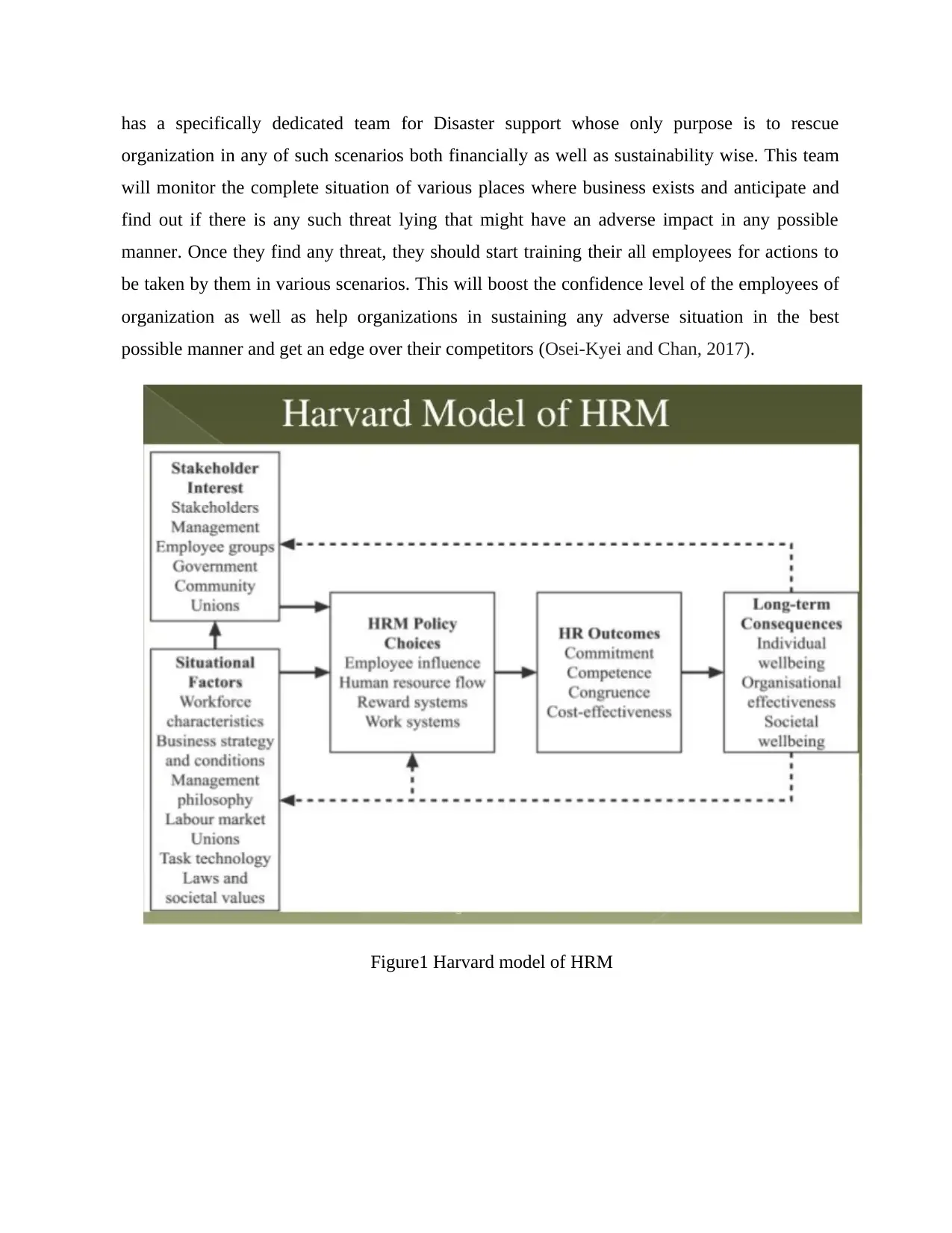
has a specifically dedicated team for Disaster support whose only purpose is to rescue
organization in any of such scenarios both financially as well as sustainability wise. This team
will monitor the complete situation of various places where business exists and anticipate and
find out if there is any such threat lying that might have an adverse impact in any possible
manner. Once they find any threat, they should start training their all employees for actions to
be taken by them in various scenarios. This will boost the confidence level of the employees of
organization as well as help organizations in sustaining any adverse situation in the best
possible manner and get an edge over their competitors (Osei-Kyei and Chan, 2017).
Figure1 Harvard model of HRM
organization in any of such scenarios both financially as well as sustainability wise. This team
will monitor the complete situation of various places where business exists and anticipate and
find out if there is any such threat lying that might have an adverse impact in any possible
manner. Once they find any threat, they should start training their all employees for actions to
be taken by them in various scenarios. This will boost the confidence level of the employees of
organization as well as help organizations in sustaining any adverse situation in the best
possible manner and get an edge over their competitors (Osei-Kyei and Chan, 2017).
Figure1 Harvard model of HRM
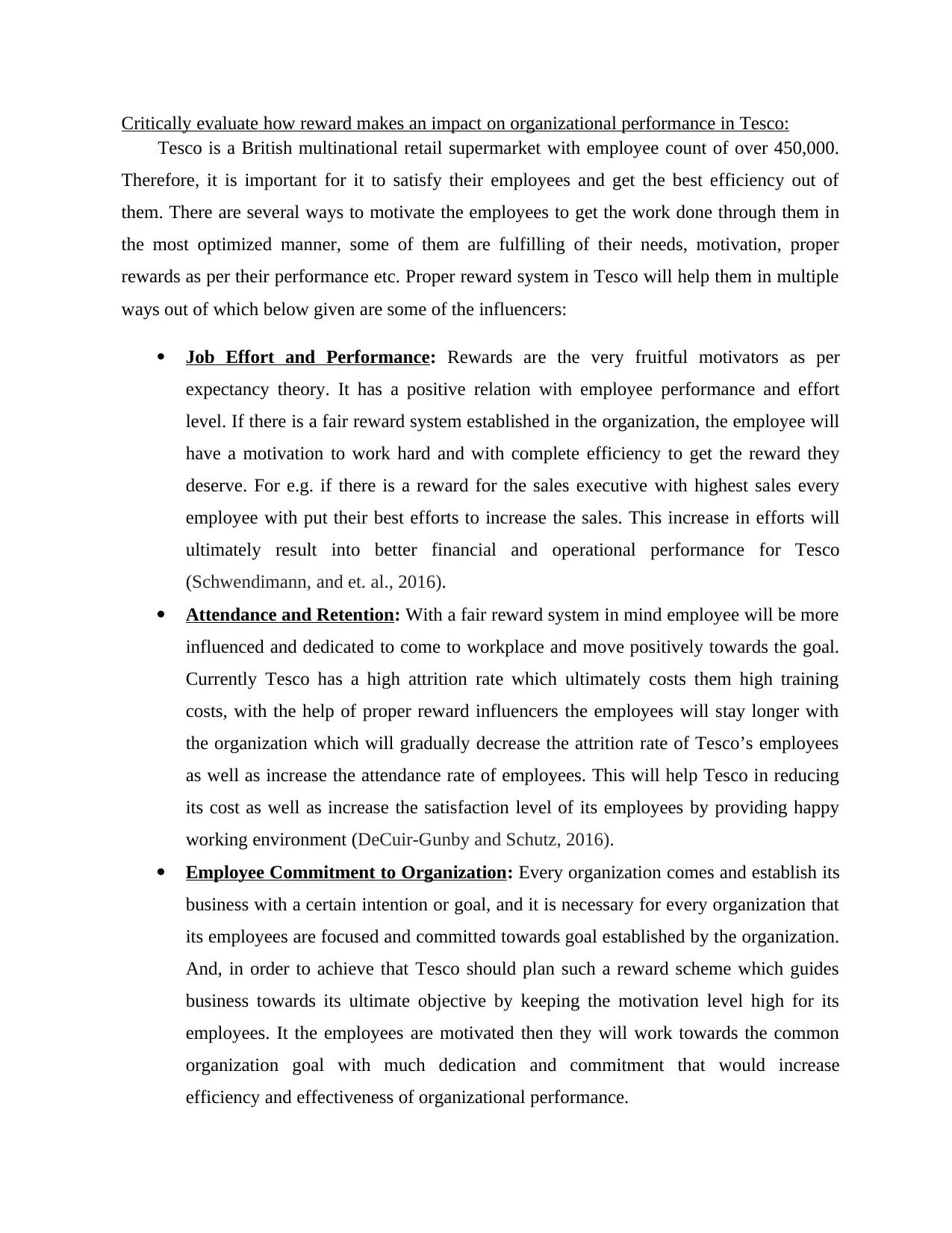
Critically evaluate how reward makes an impact on organizational performance in Tesco:
Tesco is a British multinational retail supermarket with employee count of over 450,000.
Therefore, it is important for it to satisfy their employees and get the best efficiency out of
them. There are several ways to motivate the employees to get the work done through them in
the most optimized manner, some of them are fulfilling of their needs, motivation, proper
rewards as per their performance etc. Proper reward system in Tesco will help them in multiple
ways out of which below given are some of the influencers:
Job Effort and Performance: Rewards are the very fruitful motivators as per
expectancy theory. It has a positive relation with employee performance and effort
level. If there is a fair reward system established in the organization, the employee will
have a motivation to work hard and with complete efficiency to get the reward they
deserve. For e.g. if there is a reward for the sales executive with highest sales every
employee with put their best efforts to increase the sales. This increase in efforts will
ultimately result into better financial and operational performance for Tesco
(Schwendimann, and et. al., 2016).
Attendance and Retention: With a fair reward system in mind employee will be more
influenced and dedicated to come to workplace and move positively towards the goal.
Currently Tesco has a high attrition rate which ultimately costs them high training
costs, with the help of proper reward influencers the employees will stay longer with
the organization which will gradually decrease the attrition rate of Tesco’s employees
as well as increase the attendance rate of employees. This will help Tesco in reducing
its cost as well as increase the satisfaction level of its employees by providing happy
working environment (DeCuir-Gunby and Schutz, 2016).
Employee Commitment to Organization: Every organization comes and establish its
business with a certain intention or goal, and it is necessary for every organization that
its employees are focused and committed towards goal established by the organization.
And, in order to achieve that Tesco should plan such a reward scheme which guides
business towards its ultimate objective by keeping the motivation level high for its
employees. It the employees are motivated then they will work towards the common
organization goal with much dedication and commitment that would increase
efficiency and effectiveness of organizational performance.
Tesco is a British multinational retail supermarket with employee count of over 450,000.
Therefore, it is important for it to satisfy their employees and get the best efficiency out of
them. There are several ways to motivate the employees to get the work done through them in
the most optimized manner, some of them are fulfilling of their needs, motivation, proper
rewards as per their performance etc. Proper reward system in Tesco will help them in multiple
ways out of which below given are some of the influencers:
Job Effort and Performance: Rewards are the very fruitful motivators as per
expectancy theory. It has a positive relation with employee performance and effort
level. If there is a fair reward system established in the organization, the employee will
have a motivation to work hard and with complete efficiency to get the reward they
deserve. For e.g. if there is a reward for the sales executive with highest sales every
employee with put their best efforts to increase the sales. This increase in efforts will
ultimately result into better financial and operational performance for Tesco
(Schwendimann, and et. al., 2016).
Attendance and Retention: With a fair reward system in mind employee will be more
influenced and dedicated to come to workplace and move positively towards the goal.
Currently Tesco has a high attrition rate which ultimately costs them high training
costs, with the help of proper reward influencers the employees will stay longer with
the organization which will gradually decrease the attrition rate of Tesco’s employees
as well as increase the attendance rate of employees. This will help Tesco in reducing
its cost as well as increase the satisfaction level of its employees by providing happy
working environment (DeCuir-Gunby and Schutz, 2016).
Employee Commitment to Organization: Every organization comes and establish its
business with a certain intention or goal, and it is necessary for every organization that
its employees are focused and committed towards goal established by the organization.
And, in order to achieve that Tesco should plan such a reward scheme which guides
business towards its ultimate objective by keeping the motivation level high for its
employees. It the employees are motivated then they will work towards the common
organization goal with much dedication and commitment that would increase
efficiency and effectiveness of organizational performance.
You're viewing a preview
Unlock full access by subscribing today!
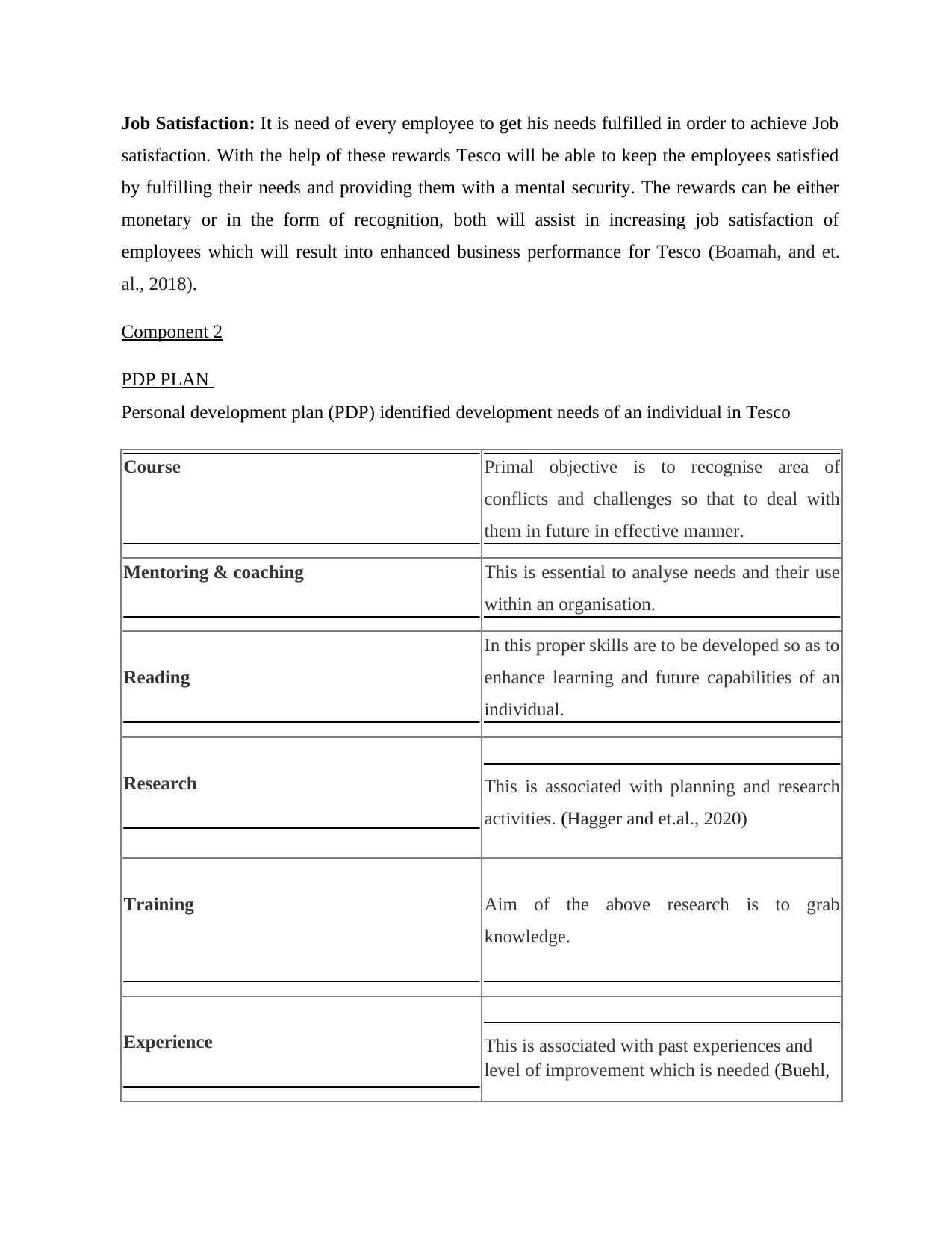
Job Satisfaction: It is need of every employee to get his needs fulfilled in order to achieve Job
satisfaction. With the help of these rewards Tesco will be able to keep the employees satisfied
by fulfilling their needs and providing them with a mental security. The rewards can be either
monetary or in the form of recognition, both will assist in increasing job satisfaction of
employees which will result into enhanced business performance for Tesco (Boamah, and et.
al., 2018).
Component 2
PDP PLAN
Personal development plan (PDP) identified development needs of an individual in Tesco
Course Primal objective is to recognise area of
conflicts and challenges so that to deal with
them in future in effective manner.
Mentoring & coaching This is essential to analyse needs and their use
within an organisation.
Reading
In this proper skills are to be developed so as to
enhance learning and future capabilities of an
individual.
Research This is associated with planning and research
activities. (Hagger and et.al., 2020)
Training Aim of the above research is to grab
knowledge.
Experience This is associated with past experiences and
level of improvement which is needed (Buehl,
satisfaction. With the help of these rewards Tesco will be able to keep the employees satisfied
by fulfilling their needs and providing them with a mental security. The rewards can be either
monetary or in the form of recognition, both will assist in increasing job satisfaction of
employees which will result into enhanced business performance for Tesco (Boamah, and et.
al., 2018).
Component 2
PDP PLAN
Personal development plan (PDP) identified development needs of an individual in Tesco
Course Primal objective is to recognise area of
conflicts and challenges so that to deal with
them in future in effective manner.
Mentoring & coaching This is essential to analyse needs and their use
within an organisation.
Reading
In this proper skills are to be developed so as to
enhance learning and future capabilities of an
individual.
Research This is associated with planning and research
activities. (Hagger and et.al., 2020)
Training Aim of the above research is to grab
knowledge.
Experience This is associated with past experiences and
level of improvement which is needed (Buehl,
Paraphrase This Document
Need a fresh take? Get an instant paraphrase of this document with our AI Paraphraser
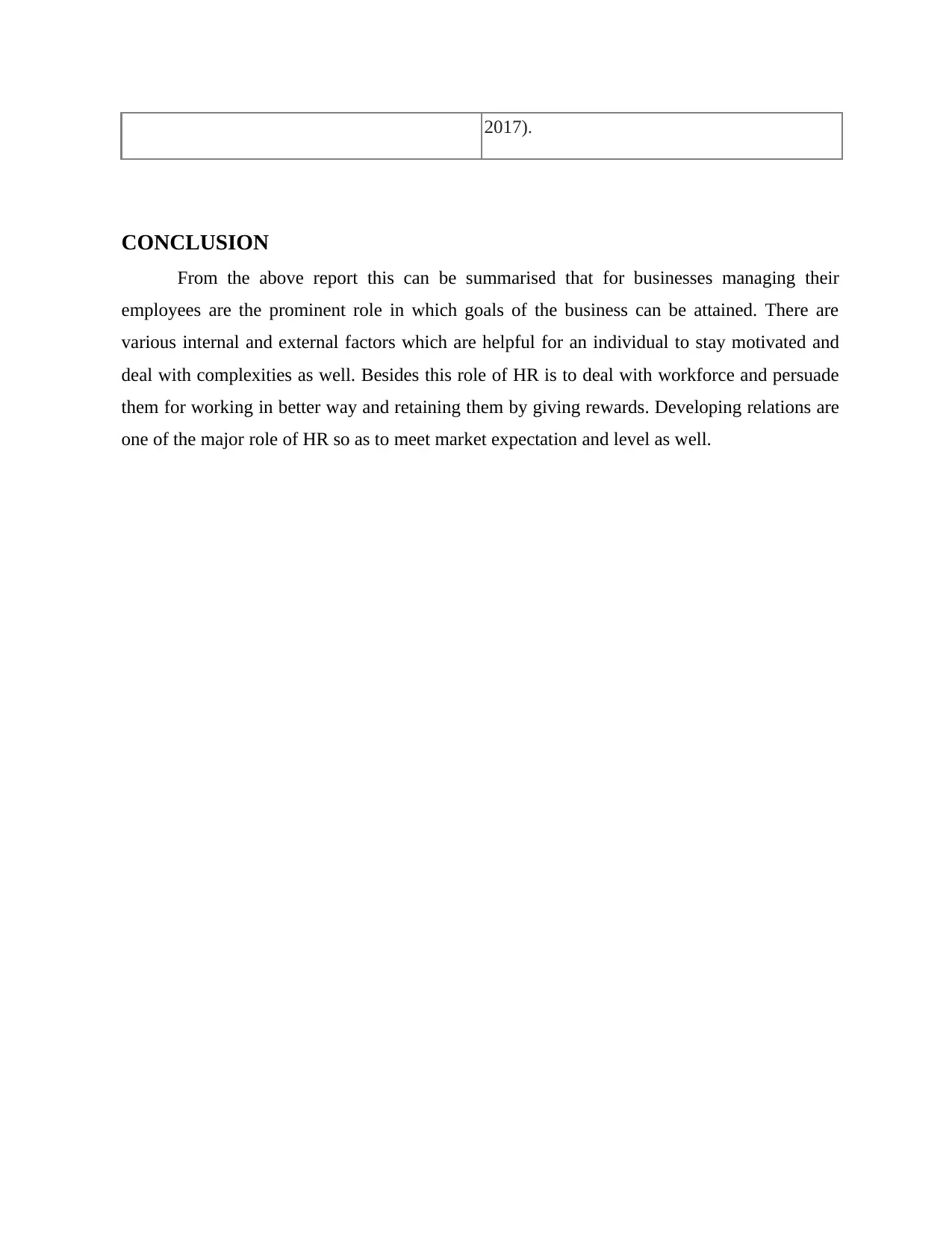
2017).
CONCLUSION
From the above report this can be summarised that for businesses managing their
employees are the prominent role in which goals of the business can be attained. There are
various internal and external factors which are helpful for an individual to stay motivated and
deal with complexities as well. Besides this role of HR is to deal with workforce and persuade
them for working in better way and retaining them by giving rewards. Developing relations are
one of the major role of HR so as to meet market expectation and level as well.
CONCLUSION
From the above report this can be summarised that for businesses managing their
employees are the prominent role in which goals of the business can be attained. There are
various internal and external factors which are helpful for an individual to stay motivated and
deal with complexities as well. Besides this role of HR is to deal with workforce and persuade
them for working in better way and retaining them by giving rewards. Developing relations are
one of the major role of HR so as to meet market expectation and level as well.

REFERENCES
Books & Journals
Bande and et. al., 2016. Exploring the relationship among servant leadership, intrinsic
motivation and performance in an industrial sales setting. Journal of Business &
Industrial Marketing.
Bennett and et. al., 2016. Reflection for learning, learning for reflection: Developing
Indigenous competencies in higher education. Journal of University teaching &
learning practice, 13(2), p.7.
Boamah, and et. al., 2018. Effect of transformational leadership on job satisfaction and patient
safety outcomes. Nursing outlook, 66(2), pp.180-189.
Bourne, L., 2016. Stakeholder relationship management: a maturity model for organisational
implementation. CRC Press.
Buehl, D., 2017. Developing readers in the academic disciplines. Stenhouse Publishers.
DeCuir-Gunby, J.T. and Schutz, P.A., 2016. Developing a mixed methods proposal: A practical
guide for beginning researchers (Vol. 5). Sage Publications.
Fallatah, R.H.M. and Syed, J., 2018. A Critical Review of Maslow’s Hierarchy of Needs.
InEmployee Motivation in Saudi Arabia(pp. 19-59). Palgrave Macmillan, Cham
Fletcher, 2019. How can personal development lead to increased engagement? The roles of
meaningfulness and perceived line manager relations.The International Journal of
Human Resource Management,30(7), pp.1203-1226.
Fountain, J. and Newcomer, K.E., 2016. Developing and sus
Godward, 2019.Personal Development Groups for Trainee Counsellors: An Essential
Companion. Routledge.
Hagger and et.al., 2020. The handbook of behavior change. Cambridge University Press.
Hauff, 2019. Exploring necessary conditions in HRM research: Fundamental issues and
methodological implications.Human Resource Management Journal.
Hezlett, S.A., 2016. Enhancing experience-driven leadership development. Advances in
Developing Human Resources, 18(3), pp.369-389.
Jalalkamali and et. al., 2016. Relationships between work values, communication satisfaction,
and employee job performance. Management Decision.
Neenan, M., 2017. Developing resilience: A cognitive-behavioural approach. Taylor & Francis.
Nicholls, 2017. Conceptions of ability and achievement motivation: A theory and its
implications for education. InLearning and motivation in the classroom(pp. 211-238).
Routledge.
Osborne, S. and Hammoud, M.S., 2017. Effective employee engagement in the
workplace. International Journal of Applied Management and Technology, 16(1), p.4.
Books & Journals
Bande and et. al., 2016. Exploring the relationship among servant leadership, intrinsic
motivation and performance in an industrial sales setting. Journal of Business &
Industrial Marketing.
Bennett and et. al., 2016. Reflection for learning, learning for reflection: Developing
Indigenous competencies in higher education. Journal of University teaching &
learning practice, 13(2), p.7.
Boamah, and et. al., 2018. Effect of transformational leadership on job satisfaction and patient
safety outcomes. Nursing outlook, 66(2), pp.180-189.
Bourne, L., 2016. Stakeholder relationship management: a maturity model for organisational
implementation. CRC Press.
Buehl, D., 2017. Developing readers in the academic disciplines. Stenhouse Publishers.
DeCuir-Gunby, J.T. and Schutz, P.A., 2016. Developing a mixed methods proposal: A practical
guide for beginning researchers (Vol. 5). Sage Publications.
Fallatah, R.H.M. and Syed, J., 2018. A Critical Review of Maslow’s Hierarchy of Needs.
InEmployee Motivation in Saudi Arabia(pp. 19-59). Palgrave Macmillan, Cham
Fletcher, 2019. How can personal development lead to increased engagement? The roles of
meaningfulness and perceived line manager relations.The International Journal of
Human Resource Management,30(7), pp.1203-1226.
Fountain, J. and Newcomer, K.E., 2016. Developing and sus
Godward, 2019.Personal Development Groups for Trainee Counsellors: An Essential
Companion. Routledge.
Hagger and et.al., 2020. The handbook of behavior change. Cambridge University Press.
Hauff, 2019. Exploring necessary conditions in HRM research: Fundamental issues and
methodological implications.Human Resource Management Journal.
Hezlett, S.A., 2016. Enhancing experience-driven leadership development. Advances in
Developing Human Resources, 18(3), pp.369-389.
Jalalkamali and et. al., 2016. Relationships between work values, communication satisfaction,
and employee job performance. Management Decision.
Neenan, M., 2017. Developing resilience: A cognitive-behavioural approach. Taylor & Francis.
Nicholls, 2017. Conceptions of ability and achievement motivation: A theory and its
implications for education. InLearning and motivation in the classroom(pp. 211-238).
Routledge.
Osborne, S. and Hammoud, M.S., 2017. Effective employee engagement in the
workplace. International Journal of Applied Management and Technology, 16(1), p.4.
You're viewing a preview
Unlock full access by subscribing today!
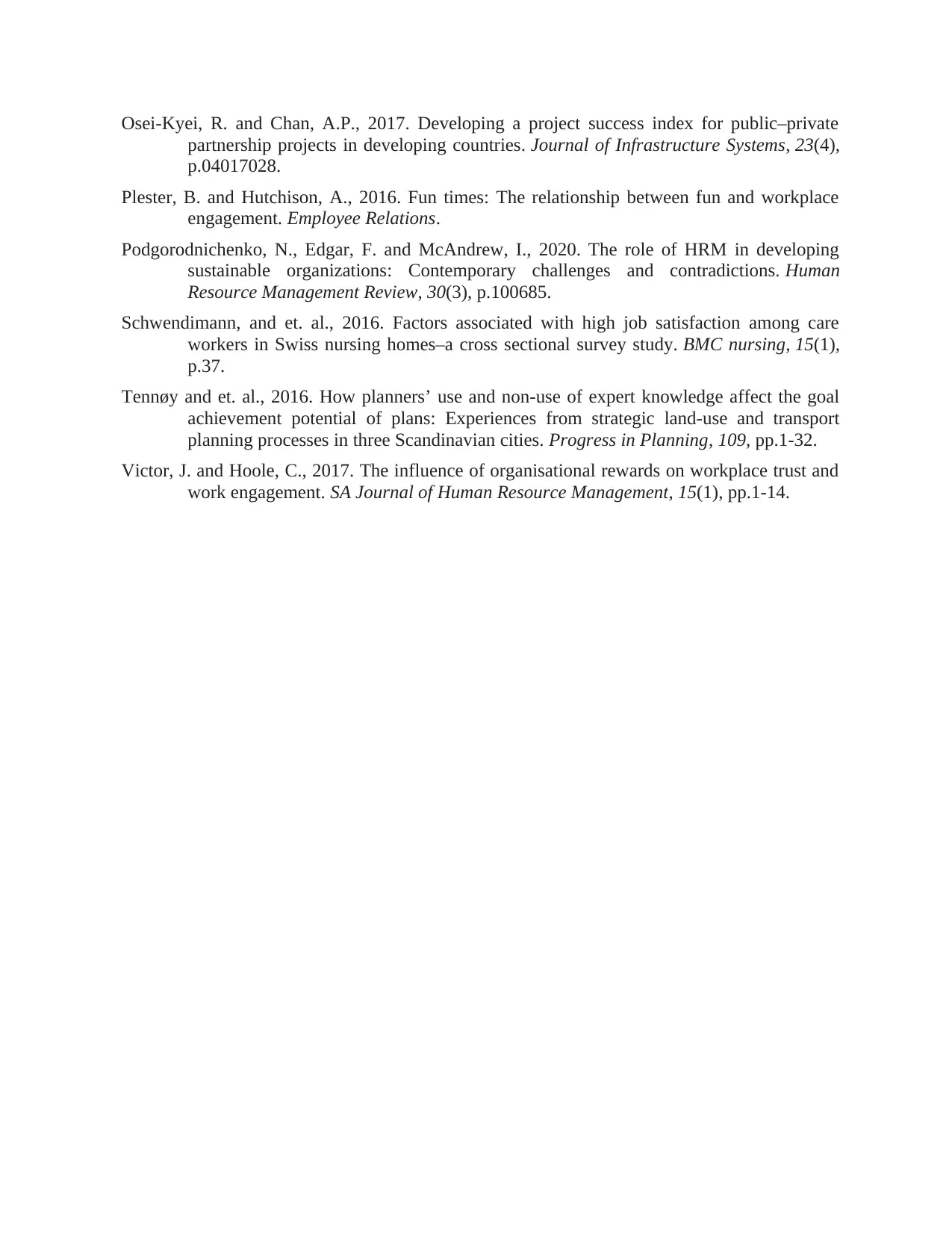
Osei-Kyei, R. and Chan, A.P., 2017. Developing a project success index for public–private
partnership projects in developing countries. Journal of Infrastructure Systems, 23(4),
p.04017028.
Plester, B. and Hutchison, A., 2016. Fun times: The relationship between fun and workplace
engagement. Employee Relations.
Podgorodnichenko, N., Edgar, F. and McAndrew, I., 2020. The role of HRM in developing
sustainable organizations: Contemporary challenges and contradictions. Human
Resource Management Review, 30(3), p.100685.
Schwendimann, and et. al., 2016. Factors associated with high job satisfaction among care
workers in Swiss nursing homes–a cross sectional survey study. BMC nursing, 15(1),
p.37.
Tennøy and et. al., 2016. How planners’ use and non-use of expert knowledge affect the goal
achievement potential of plans: Experiences from strategic land-use and transport
planning processes in three Scandinavian cities. Progress in Planning, 109, pp.1-32.
Victor, J. and Hoole, C., 2017. The influence of organisational rewards on workplace trust and
work engagement. SA Journal of Human Resource Management, 15(1), pp.1-14.
partnership projects in developing countries. Journal of Infrastructure Systems, 23(4),
p.04017028.
Plester, B. and Hutchison, A., 2016. Fun times: The relationship between fun and workplace
engagement. Employee Relations.
Podgorodnichenko, N., Edgar, F. and McAndrew, I., 2020. The role of HRM in developing
sustainable organizations: Contemporary challenges and contradictions. Human
Resource Management Review, 30(3), p.100685.
Schwendimann, and et. al., 2016. Factors associated with high job satisfaction among care
workers in Swiss nursing homes–a cross sectional survey study. BMC nursing, 15(1),
p.37.
Tennøy and et. al., 2016. How planners’ use and non-use of expert knowledge affect the goal
achievement potential of plans: Experiences from strategic land-use and transport
planning processes in three Scandinavian cities. Progress in Planning, 109, pp.1-32.
Victor, J. and Hoole, C., 2017. The influence of organisational rewards on workplace trust and
work engagement. SA Journal of Human Resource Management, 15(1), pp.1-14.
1 out of 16
Related Documents
Your All-in-One AI-Powered Toolkit for Academic Success.
+13062052269
info@desklib.com
Available 24*7 on WhatsApp / Email
![[object Object]](/_next/static/media/star-bottom.7253800d.svg)
Unlock your academic potential
© 2024 | Zucol Services PVT LTD | All rights reserved.




